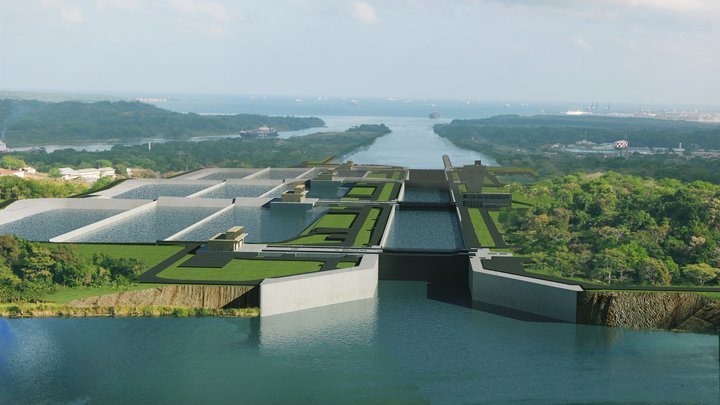Shipping around the globe is growing apace, with ever larger oil tankers and container ships plying the seas. Some are 1,700 feet long and carry up to 2,000 boxed containers. They are the essential elements of international trade.
But the shippers are running into problems, particularly at the two global choke points at Suez and Panama. The Suez Canal between the Mediterranean and Red seas has been operating since 1869. The Panama Canal between the Caribbean and the Pacific opened in 1914. World population a century ago was probably no more than one billion. Today it is seven billion. International trade has increased accordingly and the current canals can’t handle the load. At both Suez and Panama, ships have to wait in line, sometimes for days, to transit. The Panama Canal reached its operating limit last year.
Which is why the bulldozers and earth movers are rumbling at Panama and Suez in some of the largest construction projects ever seen on the planet.. The expanded Suez Canal, which will include a new canal for 70 miles of its 100 mile length, will allow simultaneous two-way shipping, and will reduce transit times from nine to three hours. Cost is estimated at $8 billion and the work is supposed to be completed next year, although there are doubts. The Egyptian government estimates that annual revenues from the canal will increase from five billion to 12 billion dollars. It regards the expanded canal zone, with five new tunnels underneath the canal connecting to the Sinaii, as key to Egypt’s future prosperity.
Across the Atlantic and Caribbean seas, expansion work is underway at the Panama Canal. Current canal “Panamax’ locks are 110 feet wide and 1000 feet long – ample for the ships of 1914, but not for the largest current oil tankers and container ships. It is estimated that about one third of world shipping is too large and cannot use the Panama Canal. The new locks will be 180 feet wide and 1,400 feet long, enough to handle the largest beams, but not long enough for the most gigantic “post Panamax” container ships.
As might be expected, there has been controversy. Environmentalists fear that increased lock use of Gatun Lake, a main source of drinking water for Panama, will increase salinization. Others argue that it would be cheaper to transit large cargoes by rail across the Isthmus, from one container ship to another. But the people of Panama have voted by impressive margins for the expansion and it is well underway. As is the case at Suez, the Panamanian government leaders are gung ho for the project which they anticipate will create thousands of jobs and make Panama a “First World nation”, to quote former President Martin Torrijos.
Another gigantic scheme, which may be in the realm of fantasy, is for an even bigger isthmus canal across Nicaragua, 50 or so miles north of Panama. Wang Jing, a Chinese tycoon, says he has secured financing for the $40 billion construction and the Nicaraguan National Assembly has approved a bill granting a 50-year concession to Mr. Jing’s Hong Kong Nicaraguan Canal Development Project.
An enthusiastic backer of the project is Daniel Ortega, president of Nicaragua. Twenty years ago he was the leader of a radical Marxist guerrilla group. Today he is promoting the gigantic canal project as the key to Nicaragua’s future. He predicts that it will create 250,000 jobs and secure a prosperous future for his country, long mired in poverty.
As can be imagined, many questions have been raised. Some doubt that Mr. Jing can raise all that money. The canal, 172 miles long, will require massive land takings, 642 square miles in all, and thousands of peasant land owners are up in arms. The environmentalists fear that the canal’s route across Lake Nicaragua, largest fresh water lake on the Isthmus, will be contaminated by the dredging that will be needed to deepen the canal. Some worry that the connection between the Caribbean and the Pacific, even though not at sea level, will transfer invasive species.
Nevertheless, plans are being drawn up, contracts are being signed and preliminary excavations at the Pacific end are already underway. It will be the largest construction job in history if it is ever completed and will be capable of handling even those ships too large for the expanded Panama Canal.
It is interesting to note that in 1902, when American engineers were considering whether to build a canal across Panama or Nicaragua, they ruled Nicaragua out because of its volcanoes. Apparently the possibility of volcanic eruption has not been much of a factor in current thinking, even though.Nicaraguan volcanoes have erupted twice in the past eight years.
Even if the Nicaraguan Canal is never built, world shipping will be greatly eased and enhanced by the expansions at Suez and Panama. That is good news for customers and shippers around the globe.
Albert B. Southwick’s column appears regularly in the Telegram & Gazette.
